airbag HONDA RIDGELINE 2013 1.G User Guide
[x] Cancel search | Manufacturer: HONDA, Model Year: 2013, Model line: RIDGELINE, Model: HONDA RIDGELINE 2013 1.GPages: 422, PDF Size: 9.29 MB
Page 23 of 422
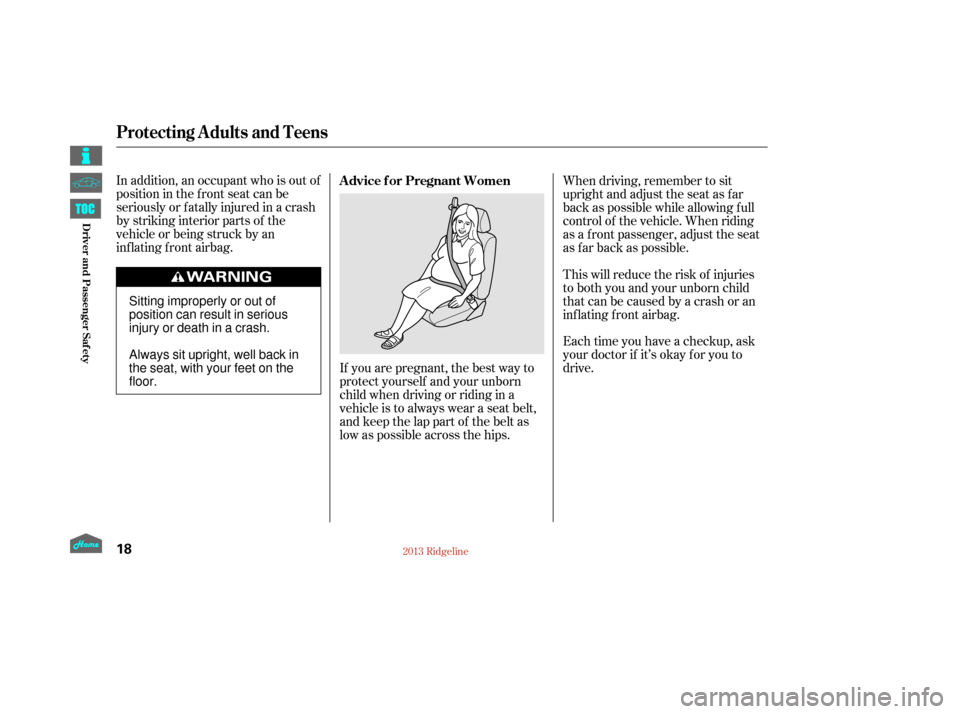
In addition, an occupant who is out of
position in the f ront seat can be
seriously or f atally injured in a crash
by striking interior parts of the
vehicle or being struck by an
inflating front airbag.If you are pregnant, the best way to
protect yourself and your unborn
child when driving or riding in a
vehicle is to always wear a seat belt,
and keep the lap part of the belt as
low as possible across the hips.When driving, remember to sit
upright and adjust the seat as f ar
back as possible while allowing f ull
control of the vehicle. When riding
as a f ront passenger, adjust the seat
as far back as possible.
This will reduce the risk of injuries
to both you and your unborn child
that can be caused by a crash or an
inflating front airbag.
Each time you have a checkup, ask
your doctor if it’s okay f or you to
drive.
Advice f or Pregnant Women
Protecting A dults and Teens
18
Sitting improperly or out of
position can result in serious
injury or death in a crash.
Always sit upright, well back in
the seat, with your feet on the
floor.
12/08/09 16:01:23 31SJC670_025
Driver and Passenger Saf ety
Page 24 of 422

If they do, they could be very
seriously injured in a crash.
If they do, they could
be killed or very seriously injured
in a crash.
They could be
killed or injured in a crash, or
become ill or even die f rom carbon
monoxide poisoning if engine
exhaust enters the cap.
A passenger who is not
wearing a seat belt during a crash
or emergency stop can be thrown
against the inside of the vehicle,
against other occupants, or out of
the vehicle. If they do, they
could be very seriously injured in a
crash.
Devices intended to improve
occupant comf ort or reposition the
shoulder part of a seat belt can
reduce the protective capability of
the seat belt and increase the
chance of serious injury in a crash.
Carrying hard or sharp
objects on your lap, or driving with
a pipe or other sharp object in
your mouth, can result in injuries
if your f ront airbag inf lates.
If your
hands or arms are close to an
airbag cover, they could be injured
if the airbag inf lates. Objects on
the covers marked ‘‘SRS AIRBAG’’
could interf ere with the proper
operation of the airbags or be
propelled inside the vehicle and
hurt someone if the airbags inf late.
If a side airbag or a
side curtain airbag inf lates, a cup
holder or other hard object
attached on or near the door could
be propelled inside the vehicle and
hurt someone.
Improperly replacing
or covering f ront seat-back covers
can prevent your side airbags f rom
inf lating during a side impact.
Protecting A dults and Teens
Additional Saf ety Precautions
Never let passengers ride in t he
area in front of a folded-up rearseat .
Never let passengers ride in t hepickup bed.
Never let passengers ride inside atruck cap (shell).
Passengers should not stand up orchange seats while the vehicle ismoving. T wo people should never use t he
same seat belt .
Do not put any accessories on seatbelts.
Do not place hard or sharp object sbet ween yourself and a f rontairbag.
K eep your hands and arms awayf rom t he airbag covers. Do not at t ach or place object s on
the f ront airbag covers.
Do not at t ach hard object s on ornear a door.
Do not cover or replace f ront seat -back covers wit hout consult ingyour dealer.
19
12/08/09 16:01:32 31SJC670_026
Driver and Passenger Saf ety
Page 27 of 422
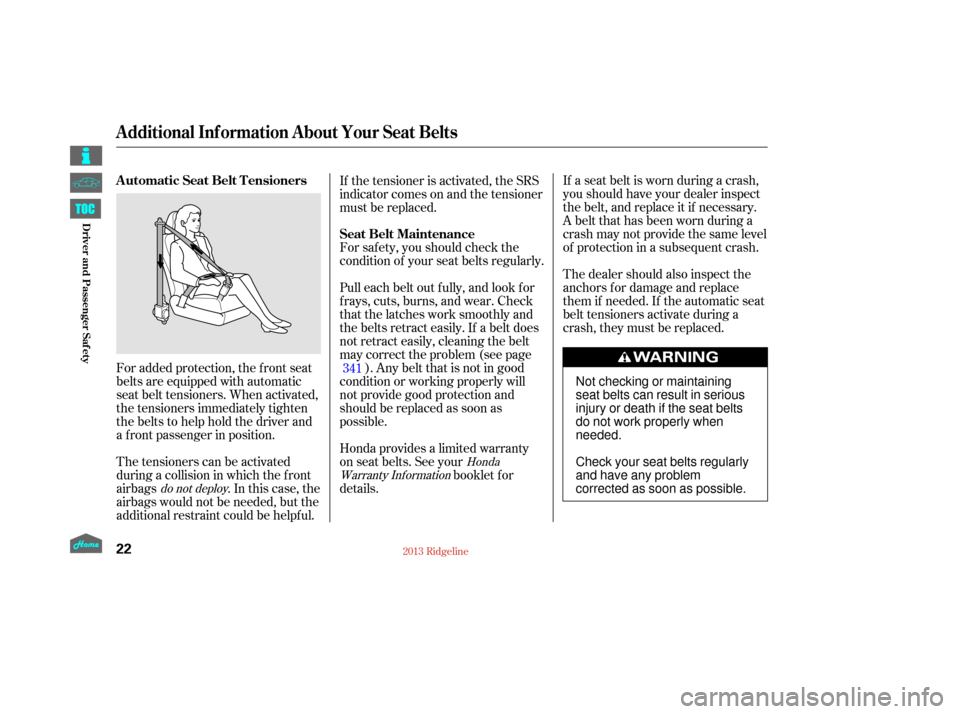
If a seat belt is worn during a crash,
you should have your dealer inspect
the belt, and replace it if necessary.
A belt that has been worn during a
crash may not provide the same level
of protection in a subsequent crash.
The dealer should also inspect the
anchors f or damage and replace
them if needed. If the automatic seat
belt tensioners activate during a
crash, they must be replaced.
If the tensioner is activated, the SRS
indicator comes on and the tensioner
must be replaced.
For saf ety, you should check the
condition of your seat belts regularly.
Pull each belt out f ully, and look f or
f rays, cuts, burns, and wear. Check
that the latches work smoothly and
the belts retract easily. If a belt does
not retract easily, cleaning the belt
may correct the problem (see page
). Any belt that is not in good
condition or working properly will
not provide good protection and
should be replaced as soon as
possible.
Honda provides a limited warranty
on seat belts. See your booklet f or
details.
For added protection, the f ront seat
belts are equipped with automatic
seat belt tensioners. When activated,
the tensioners immediately tighten
the belts to help hold the driver and
a f ront passenger in position.
The tensioners can be activated
during a collision in which the f ront
airbags
. In this case, the
airbags would not be needed, but the
additional restraint could be helpf ul. 341
Honda
Warranty Inf ormation
do not deploy
Additional Inf ormation About Your Seat Belts
Seat Belt Maintenance
A utomatic Seat Belt T ensioners
22
Not checking or maintaining
seat belts can result in serious
injury or death if the seat belts
do not work properly when
needed.
Check your seat belts regularly
and have any problem
corrected as soon as possible.
12/08/09 16:01:57 31SJC670_029
Driver and Passenger Saf ety
Page 28 of 422
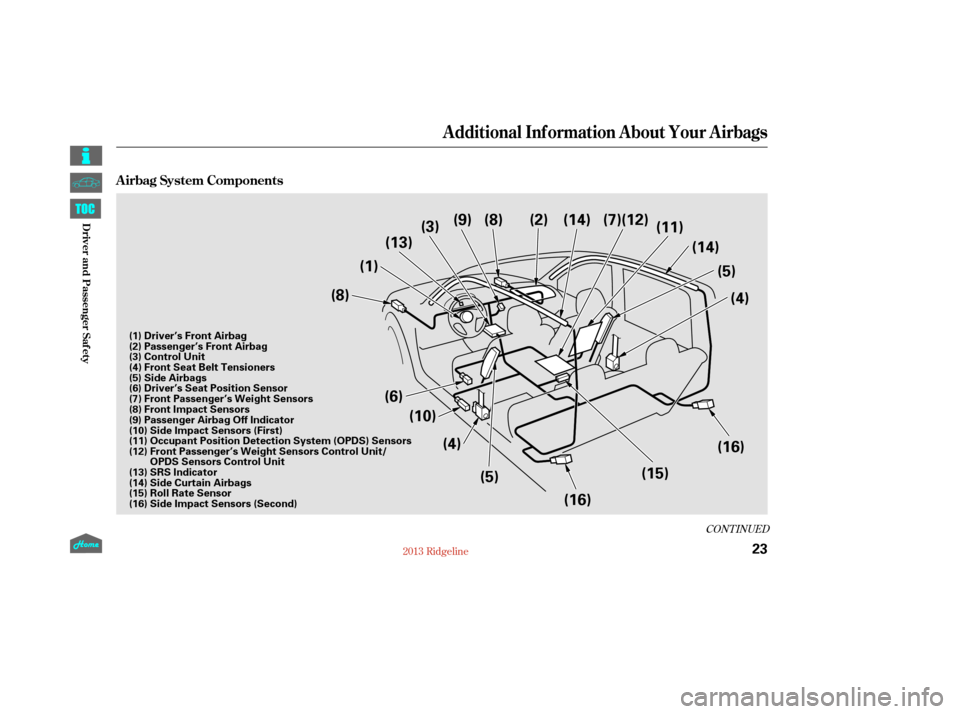
CONT INUED
A irbag System Components
Additional Inf ormation About Your Airbags
23
(1)(3)
(5)
(4) (5)
(6)
(10)
(13)
(9) (8) (2)
(16)(4)
(15)
(16)
(8)
(14) (7)(12)
(14)
(11)
(1) Driver’s Front Airbag
(2) Passenger’s Front Airbag
(3) Control Unit
(4) Front Seat Belt Tensioners
(5) Side Airbags
(6) Driver’s Seat Position Sensor
(7) Front Passenger’s Weight Sensors
(12) Front Passenger’s Weight Sensors Control Unit/
OPDS Sensors Control Unit
(13) SRS Indicator
(14) Side Curtain Airbags
(15) Roll Rate Sensor
(16) Side Impact Sensors (Second) (8) Front Impact Sensors
(9) Passenger Airbag Off Indicator
(10) Side Impact Sensors (First)
(11) Occupant Position Detection System (OPDS) Sensors
12/08/09 16:02:03 31SJC670_030
Driver and Passenger Saf ety
Page 29 of 422
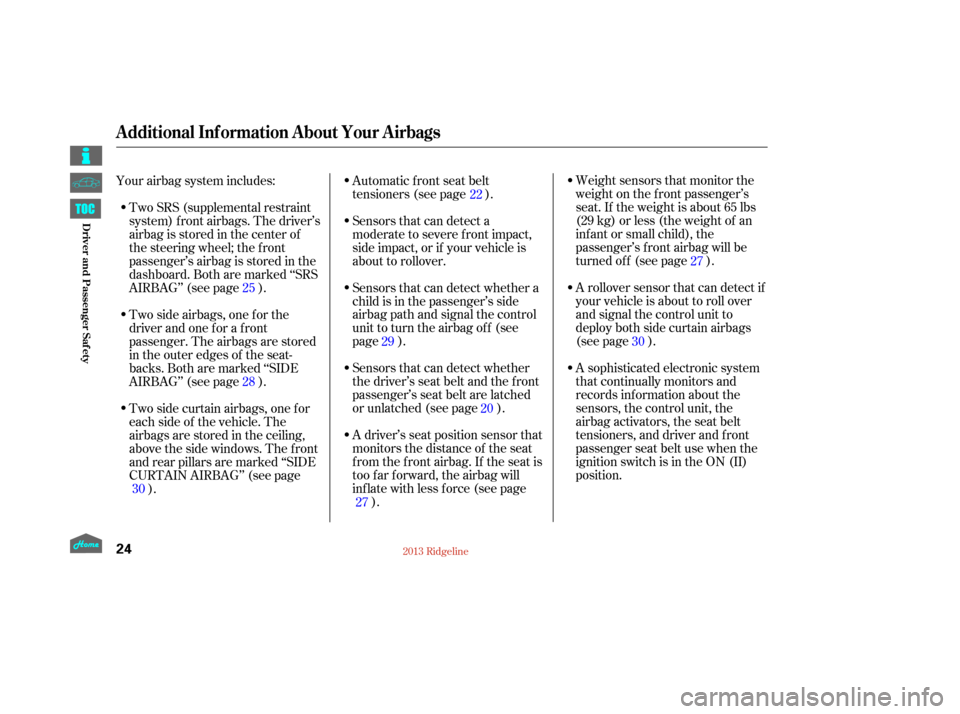
Weight sensors that monitor the
weight on the f ront passenger’s
seat. If the weight is about 65 lbs
(29 kg) or less (the weight of an
inf ant or small child), the
passenger’s f ront airbag will be
turned of f (see page ).
A rollover sensor that can detect if
your vehicle is about to roll over
and signal the control unit to
deploy both side curtain airbags
(see page ).
A sophisticated electronic system
that continually monitors and
records inf ormation about the
sensors, the control unit, the
airbag activators, the seat belt
tensioners, and driver and f ront
passenger seat belt use when the
ignition switch is in the ON (II)
position.
Automatic front seat belt
tensioners (see page ).
Sensors that can detect a
moderate to severe front impact,
side impact, or if your vehicle is
about to rollover.
Sensors that can detect whether a
child is in the passenger’s side
airbag path and signal the control
unit to turn the airbag of f (see
page ).
Sensors that can detect whether
the driver’s seat belt and the f ront
passenger’s seat belt are latched
or unlatched (see page ).
A driver’s seat position sensor that
monitors the distance of the seat
from the front airbag. If the seat is
too f ar f orward, the airbag will
inf late with less f orce (see page
).
Your airbag system includes:
Two SRS (supplemental restraint
system) f ront airbags. The driver’s
airbag is stored in the center of
the steering wheel; the f ront
passenger’sairbagisstoredinthe
dashboard. Both are marked ‘‘SRS
AIRBAG’’ (see page ).
Two side airbags, one f or the
driver and one f or a f ront
passenger. The airbags are stored
in the outer edges of the seat-
backs. Both are marked ‘‘SIDE
AIRBAG’’ (see page ).
Two side curtain airbags, one f or
each side of the vehicle. The
airbags are stored in the ceiling,
above the side windows. The f ront
and rear pillars are marked ‘‘SIDE
CURTAIN AIRBAG’’ (see page ). 27
30
27 20
29
25
28
30 22
Additional Inf ormation About Your Airbags
24
12/08/09 16:02:13 31SJC670_031
Driver and Passenger Saf ety
Page 30 of 422
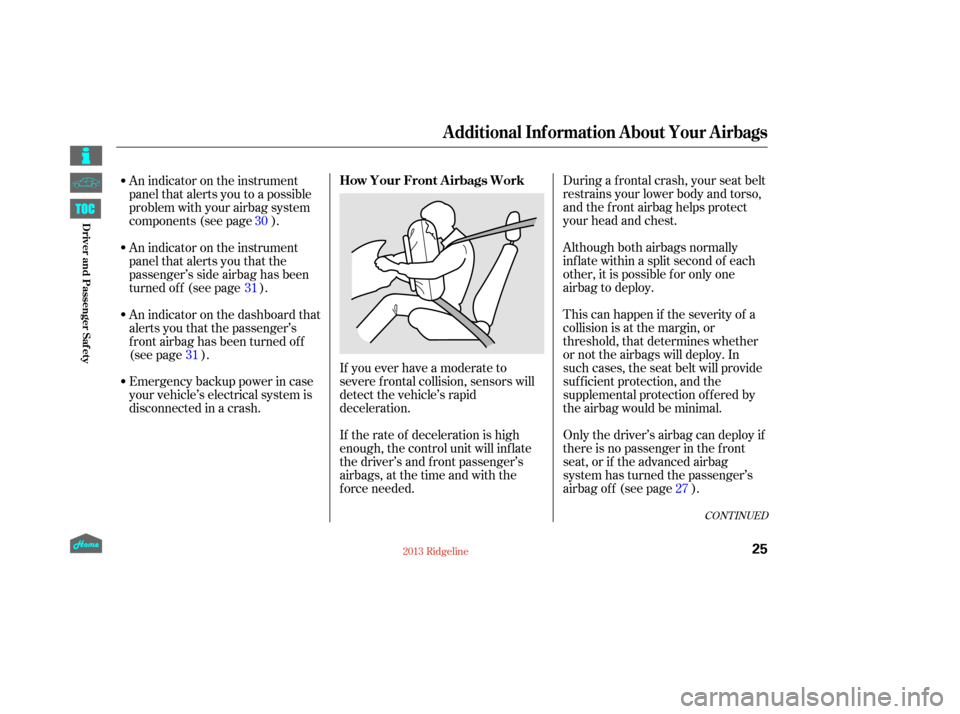
CONT INUED
During a frontal crash, your seat belt
restrains your lower body and torso,
and the f ront airbag helps protect
your head and chest.
Although both airbags normally
inf late within a split second of each
other, it is possible f or only one
airbag to deploy.
This can happen if the severity of a
collision is at the margin, or
threshold, that determines whether
or not the airbags will deploy. In
such cases, the seat belt will provide
suf f icient protection, and the
supplemental protection of f ered by
the airbag would be minimal.
Only the driver’s airbag can deploy if
there is no passenger in the f ront
seat, or if the advanced airbag
system has turned the passenger’s
airbag off (see page ).
If the rate of deceleration is high
enough, the control unit will inf late
the driver’s and f ront passenger’s
airbags, at the time and with the
f orce needed. If you ever have a moderate to
severe f rontal collision, sensors will
detect the vehicle’s rapid
deceleration.
An indicator on the instrument
panel that alerts you to a possible
problem with your airbag system
components (see page ).
An indicator on the instrument
panel that alerts you that the
passenger’s side airbag has been
turned of f (see page ).
An indicator on the dashboard that
alerts you that the passenger’s
f ront airbag has been turned of f
(see page ).
Emergency backup power in case
your vehicle’s electrical system is
disconnected in a crash.
27
30
31
31
Additional Inf ormation About Your Airbags
How Your Front A irbags Work
25
12/08/09 16:02:23 31SJC670_032
Driver and Passenger Saf ety
Page 31 of 422
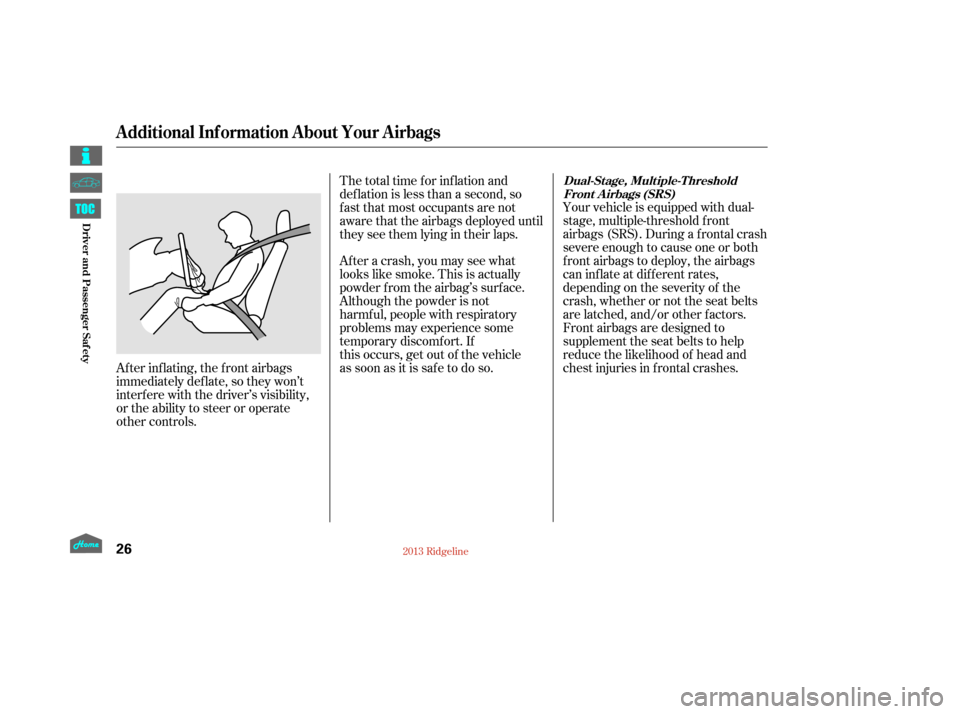
Your vehicle is equipped with dual-
stage, multiple-threshold f ront
airbags (SRS). During a f rontal crash
severe enough to cause one or both
f ront airbags to deploy, the airbags
can inf late at dif f erent rates,
depending on the severity of the
crash, whether or not the seat belts
are latched, and/or other factors.
Front airbags are designed to
supplement the seat belts to help
reduce the likelihood of head and
chest injuries in f rontal crashes.
After a crash, you may see what
looks like smoke. This is actually
powder from the airbag’s surface.
Although the powder is not
harmful, people with respiratory
problems may experience some
temporary discomfort. If
this occurs, get out of the vehicle
as soon as it is safe to do so. The total time for inflation and
def lation is less than a second, so
f ast that most occupants are not
aware that the airbags deployed until
they see them lying in their laps.
Af ter inf lating, the f ront airbags
immediately def late, so they won’t
interf ere with the driver’s visibility,
or the ability to steer or operate
other controls.
Additional Inf ormation About Your Airbags
Dual-Stage, Multiple-T hreshold Front A irbags (SRS)
26
12/08/09 16:02:28 31SJC670_033
Driver and Passenger Saf ety
Page 32 of 422
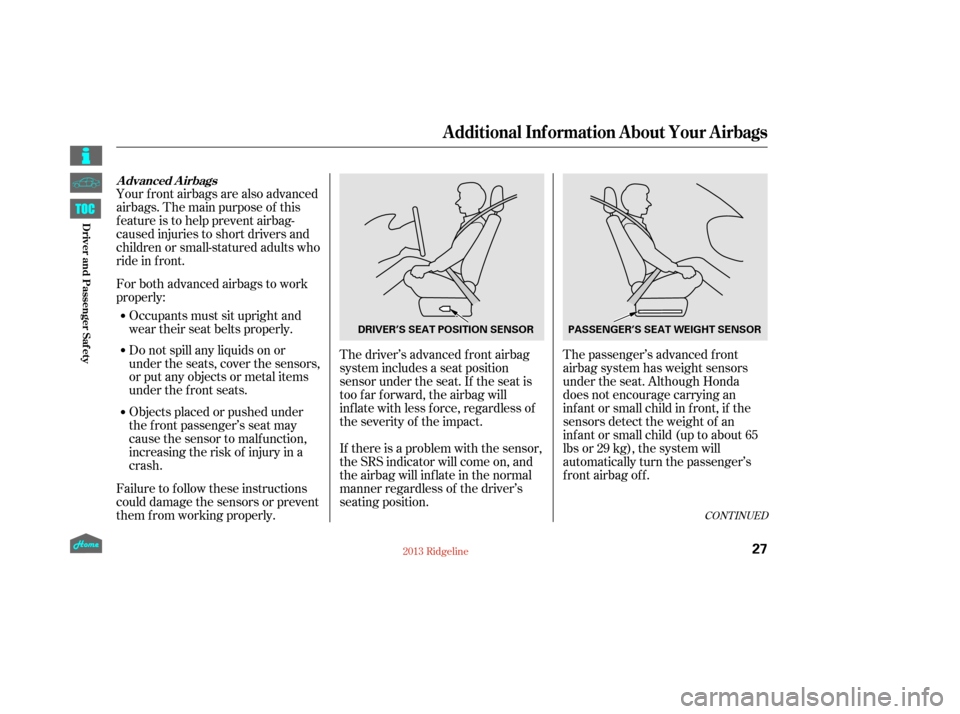
CONT INUED
Your f ront airbags are also advanced
airbags. The main purpose of this
feature is to help prevent airbag-
caused injuries to short drivers and
children or small-statured adults who
ride in f ront.The driver’s advanced front airbag
system includes a seat position
sensor under the seat. If the seat is
too f ar f orward, the airbag will
inf late with less f orce, regardless of
the severity of the impact.The passenger’s advanced f ront
airbag system has weight sensors
under the seat. Although Honda
does not encourage carrying an
inf ant or small child in f ront, if the
sensors detect the weight of an
inf ant or small child (up to about 65
lbs or 29 kg), the system will
automatically turn the passenger’s
front airbag off.
If there is a problem with the sensor,
the SRS indicator will come on, and
the airbag will inf late in the normal
manner regardless of the driver’s
seating position.
Failure to f ollow these instructions
could damage the sensors or prevent
them f rom working properly. For both advanced airbags to work
properly:
Occupants must sit upright and
wear their seat belts properly.
Do not spill any liquids on or
under the seats, cover the sensors,
or put any objects or metal items
under the f ront seats.
Objects placed or pushed under
the f ront passenger’s seat may
cause the sensor to malf unction,
increasing the risk of injury in a
crash.
Additional Inf ormation About Your Airbags
Advanced Airbags
27
DRIVER’S SEAT POSITION SENSOR PASSENGER’S SEAT WEIGHT SENSOR
12/08/09 16:02:37 31SJC670_034
Driver and Passenger Saf ety
Page 33 of 422
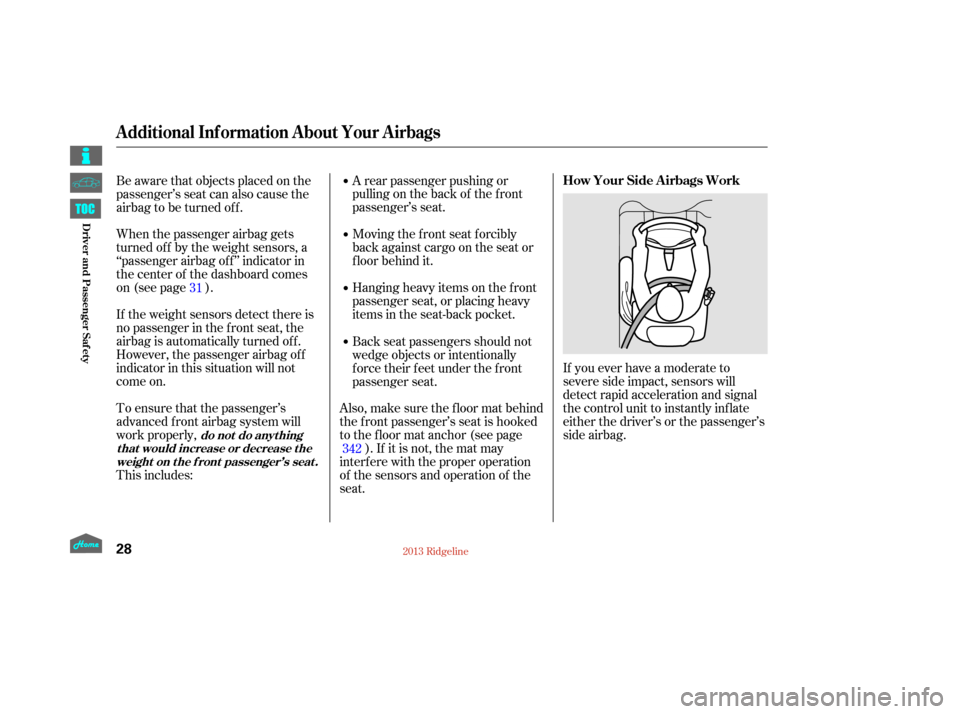
Hanging heavy items on the f ront
passenger seat, or placing heavy
items in the seat-back pocket. Moving the f ront seat f orcibly
back against cargo on the seat or
f loor behind it. A rear passenger pushing or
pulling on the back of the f ront
passenger’s seat.
When the passenger airbag gets
turned of f by the weight sensors, a
‘‘passenger airbag of f ’’ indicator in
the center of the dashboard comes
on (see page ). Be aware that objects placed on the
passenger’s seat can also cause the
airbag to be turned off.
If you ever have a moderate to
severe side impact, sensors will
detect rapid acceleration and signal
the control unit to instantly inf late
either the driver’s or the passenger’s
side airbag.
To ensure that the passenger’s
advanced front airbag system will
work properly,
This includes: If the weight sensors detect there is
no passenger in the f ront seat, the
airbag is automatically turned off.
However, the passenger airbag of f
indicator in this situation will not
come on.
Also,makesurethefloormatbehind
the f ront passenger’s seat is hooked
to the floor mat anchor (see page). If it is not, the mat may
interf ere with the proper operation
of the sensors and operation of the
seat. Back seat passengers should not
wedge objects or intentionally
f orce their f eet under the f ront
passenger seat.
31
342
Additional Inf ormation About Your Airbags
How Your Side A irbags Work
do not do anyt hing
t hat would increase or decrease t he weight on the f ront passenger’s seat.
28
12/08/09 16:02:46 31SJC670_035
Driver and Passenger Saf ety
Page 34 of 422

To get the best protection f rom the
side airbags, front seat occupants
should wear their seat belts and sit
upright and well back in their seats.Your vehicle has a side airbag cutoff
system designed primarily
to protect a child riding in the front
passenger’s seat.
If the side airbag of f indicator comes
on (see page ), have the
passenger sit upright. Once the
passenger is out of the airbag’s
deployment path, the system will
turn the airbag back on, and the
indicator will go out.
There will be some delay between
the moment the passenger moves
into or out of the airbag deployment
pathandwhentheindicatorcomes
on or goes of f .
A f ront seat passenger should not
use a cushion or another object as a
backrest. It may prevent the cutof f
system f rom working properly.
Although Honda does not
encourage children to ride in front,
if the position sensors detect a
child has leaned into the side
airbag’s deployment path, the
airbag will shut off.
Objects placed on the f ront
passenger seat can also cause the
side airbag to be shut of f . Thesideairbagmayalsoshutoff if a
short adult leans sideways, or a
larger adult slouches and leans
sideways into the airbag’s
deployment path.
Only one airbag will deploy during a
side impact. If the impact is on the
passenger’s side, the passenger’s
side airbag will deploy even if there
is no passenger.
31
Additional Inf ormation About Your Airbags
Side A irbag Cut of f Syst em
29
12/08/09 16:02:53 31SJC670_036
Driver and Passenger Saf ety